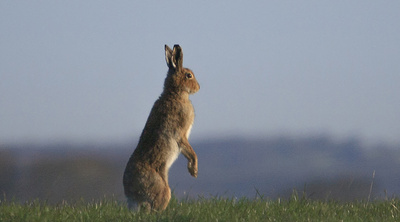National Hare Survey and Population Assessment 2017-2019



Female |
Male |
|---|---|
| Length 52 to 62 cm; Weight 3–3.6kg | Length 52 to 62 cm; Weight 3–3.6kg |
Photo: ©Andrew Kelly

The Irish hare is a unique subspecies found only on the island of Ireland. It is one of the three lagomorphs (hares and rabbits) found on the island and the only one considered native. The other two lagomorph species found on the island of Ireland are brown hares, which occur in Northern Ireland, and rabbits, which are widespread.
Carbon dating from fossil remains throughout the country has shown that the Irish hare has been present since the end of the last glacial maximum 12,900 years ago. Genetic studies indicate that the Irish hare is more closely related to mountain hare populations in mainland Europe than those in Scotland.
Photo: ©Samantha Ball

The Irish hare is widespread throughout the country and is found in habitats ranging from coastal dunes to mountain tops. Densities, however, appear to fluctuate from year to year and often from habitat to habitat.
The Irish hare has been legally protected since 1930 in the Republic of Ireland, initially under the Game Preservation Act (1930), then by the Wildlife Act (1976) and Wildlife (Amendment) Act 2000. It is listed in Appendix III of the Berne Convention, Annex V(a) of the EC Habitats Directive (92/43/EEC) and as an internationally important species in the Irish Red Data Book. However, it is also classified as a game or quarry species and may be hunted under licence during the open season. Under licence, hares are captured for coursing.
The Irish hare belongs to the species mountain hare, Lepus timidus, of which there are at least sixteen subspecies, the Irish hare only being found in Ireland. Mountain hares are widespread in Russia, Scandinavia, the European Alps, Scotland, and northern England.

Irish hares are much larger than rabbits, with females tending to be a little larger than males and dominate them throughout the year, including during the breeding season, when hares seen ‘boxing’ are likely to be dominant females boxing males.
The coat of the Irish hare is generally russet brown. However, much darker and lighter individuals have been recorded. Unlike other mountain hares, the Irish hare rarely turns white in the winter. Nevertheless, hares with large areas of white have been observed. The tail and underbelly are always white. While the ears are long, they are shorter than the length of the head (while in brown hares, ears are longer than the head). During the winter, the ears can be fringed with white fur.
Irish hares do not dig burrows but instead create shallow depressions called forms in sheltered spots. These are often found in dense vegetation such as rushes, heather, tall grass, or hedgerows.
Hares may also use bare peat or soil, including ploughed fields. Forms provide excellent camouflage, and hares usually remain hidden until they suddenly dash away just before being stepped on. In addition to offering concealment, forms help protect hares from the wind. In open landscapes, they are typically positioned to give a clear view of the surroundings, allowing hares to spot potential dangers.
The diet of the Irish hare varies between habitat and season. It is composed mainly of grasses, but heather and sedges can be an important food source in habitats where they are available.
Irish hares consume a wide variety of plant species, and in one study, 26 different species were recorded. Browse species, such as Birch and Willow, are probably taken more in the winter months, particularly during periods of snow cover. In general, hares tend to be nocturnal animals, feeding mainly at night and being inactive in the day.
Female Irish hares have been recorded breeding in most months of the year. However, peak breeding probably occurs during spring and summer.
When a female enters oestrus (breeding condition), she is often followed by a group of eager males competing for her attention. This rivalry leads to chases and fights, with boxing matches frequently occurring, most often between an unwilling female and an overly persistent male.
Each female may produce two to three litters per year. The litter sizes range from one to four. The gestation period is about 50 days.
Unlike rabbits, leverets (young hares) are born above ground. They are fully furred, have their eyes open and will hide in thick vegetation. To protect them from being detected by predators, their mother will only feed the leverets once a day, usually around dusk. The litter stays together for the first few days but then disperses to the surrounding area. The young hares grow rapidly and are weaned by about 21 days. Juvenile mortality is high, with only one out of every five leverets surviving their first year. Maximum lifespan is thought to be in the range of nine years.
The Irish hare faces several threats that are putting its population at risk. Changes in farming methods, including increased use of heavy machinery, high numbers of livestock, and a decline in the variety of grasses grown on farmland, have all had a negative impact.
Another major concern is the introduction of the European (or brown) hare. Research indicates that this species competes with the Irish hare for food and habitat. In addition, the European hare carries diseases like European Brown Hare Syndrome, which could be deadly to the native Irish hare.
There is also growing evidence that the two species are interbreeding. Sightings of them engaging in typical mating behaviours, such as sparring and boxing, have been reported. Studies of roadkill have found evidence of hybrid hares. This mixing of species will weaken the unique genetic identity of the Irish hare, which is found nowhere else in the world.
